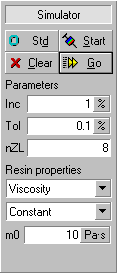
RTM-Worx Overview
Calculation
Running the simulation
 Running the simulation is as easy as pushing the button when you defined the model. This sounds
easy and it really is. When the model is not complete, properties are missing or invalid
properties have been used (like a negative thickness for example), RTM-Worx does the most
reasonable job possible. The ability to run the simulation at any time makes it possible to use it
to verify the correctness of the model. When you run the simulation, the filling of the mould will
proceed in small time steps that are governed by the element size. You can define the increment of
fill at which results are saved. The increment is typically set to 1% (saves about 100 steps) to
5% (the default, will save about 20 time steps). The calculation can be aborted anytime and
continued where you stopped it.
Running the simulation is as easy as pushing the button when you defined the model. This sounds
easy and it really is. When the model is not complete, properties are missing or invalid
properties have been used (like a negative thickness for example), RTM-Worx does the most
reasonable job possible. The ability to run the simulation at any time makes it possible to use it
to verify the correctness of the model. When you run the simulation, the filling of the mould will
proceed in small time steps that are governed by the element size. You can define the increment of
fill at which results are saved. The increment is typically set to 1% (saves about 100 steps) to
5% (the default, will save about 20 time steps). The calculation can be aborted anytime and
continued where you stopped it.
![[top]](../asp/tp.gif) Calculation details
Calculation details
RTM-Worx uses a combination of the Finite Element and Control Volume methods to solve the flow of the resin. Two basic elements types are available:
- 1D linear line element to model runners, connectors and easy flow paths. The pressure varies linearly in between the vertices.
- 2D linear plane triangle to model surfaces. The pressure varies linearly between the three vertices.
Actually, for the types of elements used, the formulation for the FEM and CV methods is
identical. This is important because it allow the use of one single method to calculate (1)
pressures and velocities and (2) to track the progression of the flow front. It also ensures that
continuity of mass is mathematically exact. Of course, the model is an approximation of reality,
but the fact that the calculation is consistent makes RTM-Worx very reliable and allows you to use
and trust it without specialised and detailed knowledge of the underlying theory. Simply repeat a
calculation with a refined mesh (a few clicks with the mouse) and you'll know the accuracy of
the predicted filling time!
Each Finite Element node (a vertex of a line or triangular element) has an associated volume that
is composed of parts of the connected elements: 50% of the volume of each line element and in
between 0% to 50% of the volume of each connected triangular element. The contribution of
triangular elements is shape dependent and only equals one third (33%) when the triangle is
equilateral.
The nodal Control Volumes are empty, partly filled or full. Partly filled nodes define the current
flow front. Empty nodes do not participate in the calculation of pressures. The calculation
proceeds in small time steps, where the number of time steps taken typically equals the number of
nodes:
- Solve pressures and velocities.
- Use calculated velocities to calculate the time increment that can be taken to fill exactly one node at the flow front.
- Use the flow rate at the front nodes (time increment times local velocity) to update the state of the front nodes. A front node that becomes filled (at least one each step) is promoted to full node and all it's neighbours that are still empty become front nodes.
- Go to step 1 until the mould is full (actual criterion is: zero flowrate).
For a user-defined number of time steps, the results are written to file. Sufficient
information is saved to display all results and to restart the calculation.
The number of elements and the product geometry governs accuracy of the calculation. The
dependence upon the geometry stems from the fact that the pressure gradient on elements is linear:
you need one element to predict filling a strip using edge injection (linear pressure drop), but a
lot of elements for point injection (logarithmic pressure gradient that has to be approximated by
straight line segments). Typically, about 1000 elements will provide sufficient accuracy
(numerical error less than 1%) and calculation times will be less than a minute. This synchronises
calculation speed with your creative thinking and will lead to full exploitation of what RTM-Worx
has to offer.
home |
introduction |
requirements |
user interface |
geometry editor
material and process data |
mesh generation |
pre- and postprocessing
file system
© 1997-2022 Polyworx
![[home]](../asp/pwxpwx.gif)